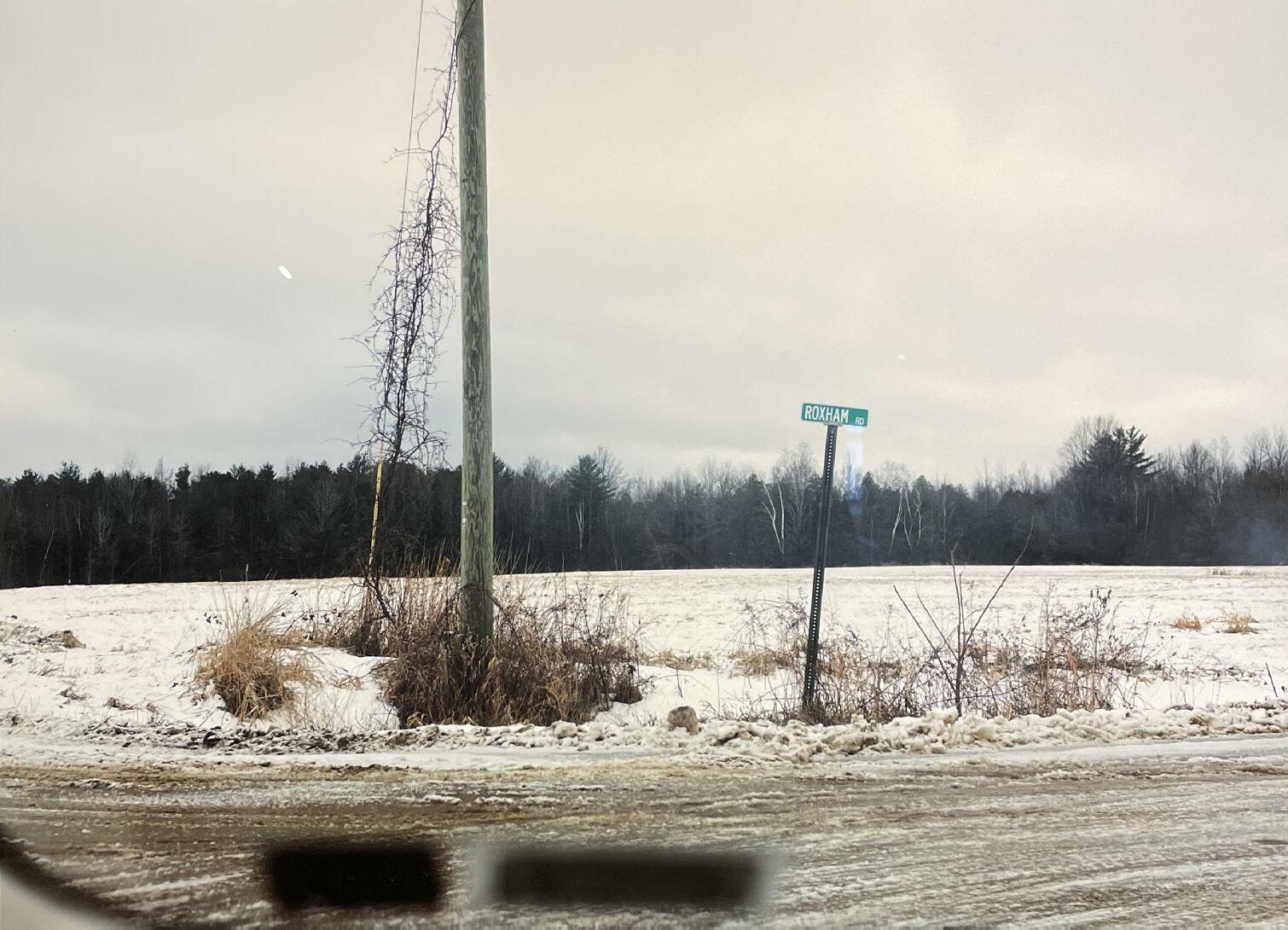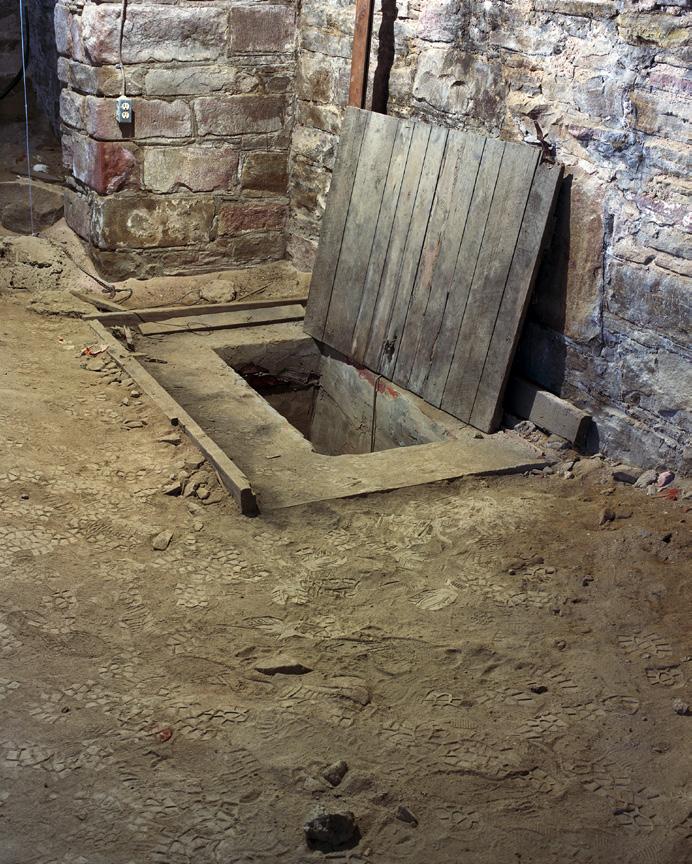ARTIST STATEMENT
Roxham Road is in my backyard. I was raised, and still live in Plattsburgh, NY, 20 miles south of the Canadian border. The locals call this region, which extends from the Adirondacks east to Lake Champlain and north to Canada, the North Country.
It isn’t clear when, how, or why Roxham Road became the primary route for asylum seekers entering Canada. It’s only a half-mile long and is located amidst a borderline stretch of dairy farms, corn fields, woods, and a scattering of modest houses.

From 2017 to early 2020 (when the pandemic closed the border), more than 90% of the nearly 60,000 asylum seekers who entered Canada through irregular routes did so at Roxham Road. After the reopening of the border in January 2022, the Roxham crossing handled nearly 10,000 individuals in the first four months alone.1
I first visited Roxham Road in June 2017. Reports of asylum seekers in the North Country had made the local and national news, and I was outraged by the growing hostility in the U.S. toward anyone who wasn’t white or Christian.
As of October 2022, this number was 23,196.
1.
Sign, Roxham Road, 2020
Because of what it had become, everything on Roxham Road carried heightened meaning for me. No longer was it traveled only by area residents, the mail truck, the school bus, or the snow plow.
Now, footprints and tire tracks spoke more of immigration and asylum than local traffic.
During more than a year of frequenting Roxham Road, I had refrained from directly photographing people due to the difficulty of requesting permission under such circumstances. And yet, increasingly, I felt it was important to record the passage of asylum seekers into Canada, given what it signified about immigration policies in the United States.
So, I set up a camera to the side of the parking area and videotaped individuals and families as they conferred with the Royal Mounted Canadian Police before they walked across the border.
 Border Crossing (Grid of Nine), Roxham Road, installation view, 2022
Border Crossing (Grid of Nine), Roxham Road, installation view, 2022
The videos were heartbreaking. Canada was the last option for the asylum seekers—neither their home countries nor the United States were safe or viable. From each video, I still-captured a frame and digitally produced a soft, white, pod-like shape over each seeker’s head. Even though their backs were to the camera, the pod nonetheless denies the viewer the ability to fully witness moments of profound vulnerability. And, for me, it pays homage to the asylum seeker’s journey.
My time at Roxham Road challenged me to interrogate my role, as a white man, in the photographs I made. This is my home; I would remind myself. But what is my place in it? How do I bear witness without following the tired tropes that only perpetuate injustice? How do I make empathic photographs with layers of connective meaning?
The steady stream of asylum seekers traveling through the United States to Canada has often been referred to as the new Underground Railroad. While the reasons behind the exodus are varied and complex, it’s hard to not assign racial and religious factors to exclusionary U.S. immigration policies and the toxic intolerance many Americans hold towards immigrants. In the North Country, the idea of the crossings at Roxham Road recapitulating history makes sense, for the area was once an Underground Railroad corridor. The major east/west thoroughfare running along the border that takes you to Roxham is called North Star Road. The road was named years ago for the use of the North Star as a navigational aid by enslaved people seeking freedom.
I plied Don Papson, a local historian and co-founder of the North Star Underground Railroad Museum, for information on known underground railroad sites in the region. Among the places he led me to was the town of Keeseville, where Frederick Douglass spoke in 1843, as did abolitionist Gerrit Smith a few years later. The building where Douglass lectured still stands, and I found it extraordinary that a local (Wendell Lansing, an abolitionist publisher) had the sway to bring in the great orator.
My interest in photographing local Underground Railroad sites is based on a simple premise; they hold a history of abolitionism. And, considering that freedom seekers are once again traveling through the North Country to Canada, the sites become monuments to the racial equity work yet to be done.
L: Tunnel, 1st Congregational Church. Underground Railroad Site, Malone, NY, 2018

R: Cabinet card of John Brown, Library of Congress, 2022

Eventually, I made my way to North Elba, in the Adirondacks, where John Brown had lived and his farmhouse still stands. Brown and his family moved to North Elba in 1849 to farm on land purchased from Gerrit Smith, and to contribute agricultural expertise and support to local Black farmers. Smith owned enormous tracts of land in New York State and, knowing that a man needed to be a landowner to vote, he gave forty-acre plots to Black American men (women weren’t yet allowed to vote.) Many of Smith’s donated parcels were located in and around North Elba.
John Brown stayed in North Elba until June 1859, when he and some of his children and neighbors left for the South to set up operations for their raid on the Harpers Ferry armory.
As I read more about Brown, his role in Roxham Road to North Elba deepened. John Brown’s unequivocal demand for racial (and gender) equality in antebellum America rings true today in a country still divided by the myth of race.
His abolitionism informs me as I think of asylum seekers passing through my backyard to Canada, often because they fear (or aren’t permitted) to stay in the United States. He inspires me to be a more engaged advocate for my brothers and sisters in the U.S. who live in a system that, from the beginning, has been rigged against them. For abolitionists today, I believe all roads lead to North Elba.
— Bill McDowell
EAST WALL
1 Asylum Plea, Roxham Road, 2017
SOUTH WALL
2 Shadow, Graph Paper 1, 2020
3 Clock Hand, Keeseville, NY, 2020
4 Detail, John Brown Bust (eye), Tufts University, Medford, MA, 2021.
5 Suit, Roxham Road, 2017
6 Shadow, Graph Paper 2, 2020
WEST WALL
7 Sign, Roxham Road, 2020
8 Border Crossings (Grid of Nine), Roxham Road, 2018-2019
9 Snow, Roxham Road, 2020
NORTH WALL
10 BLM Banner and Flowers, Keeseville, NY, 2020
11 Tunnel, 1st Congregational Church. Underground Railroad Site, Malone, NY, 2018
12 Stephen Keese Smith Barn, Underground Railroad Site, Pera, NY, 2020
13 Lawn Jockey Shadow, Near Au Sable Chasm, NY, 2020
All works courtesy of the artist and available for purchase: 20 x 25" photographs: $2,500 each (editions of 15)
8 x 10" photographs: $500 each (editions of 25)
For a listing of the additional 37 8 x 10" photographs please view the gallery labels or visit our website.
SELECT CHECKLIST includes 20 x 25" inkjet prints
1 2 3 4 5 6 7 98 13 12 11 10 ENTRANCE
FAMILY ART SATURDAY
Saturday, October 22, November 26, and January 28, 2023, 11am – 1pm BCA Center, Fourth Floor
Get creative and make art together! Families can drop-in at the BCA Center in-person and enjoy and art activity inspired by our gallery exhibitions.
ARTIST TALK WITH BILL MCDOWELL
Thursday, November 10, 6pm BCA Center, 2nd Floor
Bill McDowell discusses his multi-year photographic project and BCA installation, Roxham Road to North Elba. McDowell shares the evolution of his project and its relationship to his current creative practice before moving to Q&A in the exhibition gallery.
ROXHAM ROAD AT UVM
October 10-November 4, 2022
Colburn Gallery, Williams Hall, University of Vermont
Roxham Road, a companion exhibition to BCA’s William McDowell: From Roxham Road to North Elba includes landscape photographs and a sound installation created in collaboration with Jenn Karson.
Support for Bill McDowell and his project Roxham Road to North Elba is made possible in part by The Humanities Center at the University of Vermont.
Sponsored in part by The Maslow Family Foundation. Hospitality sponsors: Lake Champlain Chocolates, Farrell Distributing, and Prophecy Wines.
Burlington City Arts is supported by the National Endowment for the Arts and by the Vermont Arts Council.
135 CHURCH STREET, BURLINGTON, VERMONT, 05401 BURLINGTONCITYARTS.ORG
RELATED PROGRAMMING



 Border Crossing (Grid of Nine), Roxham Road, installation view, 2022
Border Crossing (Grid of Nine), Roxham Road, installation view, 2022

